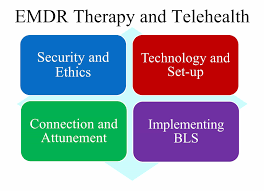Eye Movement Desensitization and Reprocessing (EMDR) is a powerful therapeutic technique used to help individuals process and heal from traumatic memories. Since its development by Dr. Francine Shapiro in the late 1980s, EMDR has gained widespread recognition for its effectiveness in treating post-traumatic stress disorder (PTSD), anxiety, and other emotional disturbances. For professionals interested in becoming certified in this therapy, completing Basic EMDR training is the first essential step.
What is Basic EMDR Training?
Basic EMDR training is designed to equip mental health professionals with the knowledge, skills, and techniques necessary to use EMDR therapy with clients. The training is thorough and comprehensive, typically broken into two parts, and includes theoretical instruction, supervised practice, and hands-on application.
Why Choose EMDR Therapy?
EMDR therapy stands out from other forms of therapy due to its structured, phase-based approach and its focus on reprocessing disturbing memories. By utilizing bilateral stimulation, such as guided eye movements, EMDR helps the brain reprocess traumatic experiences, reducing the emotional impact they once held. Many therapists who undergo Basic EMDR training are drawn to the method because of its ability to bring lasting relief to clients in a relatively short period.
Prerequisites for Basic EMDR Training
Not everyone can enroll in Basic EMDR training. Typically, it is open to licensed mental health professionals such as:
· Psychologists
· Social workers
· Counselors
Marriage and family therapists
Psychiatric nurses in some cases, professionals working toward licensure may also be eligible, provided they are in supervised settings.
What Does Basic EMDR Training Involve?
Basic EMDR training usually consists of two parts, often referred to as Part 1 and Part 2, with each part spanning multiple days or weekends. Here’s a breakdown of what each part covers:
Part 1: Foundation of EMDR Therapy
Introduction to the Adaptive Information Processing (AIP) Model: This model forms the theoretical basis for EMDR therapy, explaining how trauma disrupts the brain’s natural processing abilities.
The Eight Phases of EMDR Therapy: Trainees are introduced to the step-by-step process of EMDR, from history-taking to re-evaluation.
Hands-On Practice: Trainees practice administering EMDR therapy in a supervised environment, focusing on key techniques like bilateral stimulation and desensitization.
Part 2: Advanced Techniques and Clinical Application
Complex Case Management: Part 2 dives deeper into more challenging cases, such as those involving multiple traumas, dissociation, or complex PTSD.
Refinement of Skills: Trainees continue practicing their skills, receiving feedback and guidance from experienced EMDR trainers.
Certification Preparation: After completing Part 2, trainees are better prepared to move forward with certification, should they choose to pursue it.
The Eight Phases of EMDR Therapy
One of the most significant aspects of Basic EMDR training is learning the eight phases of the therapy. These phases are designed to take the client through a structured healing process:
History-Taking: Gathering detailed information about the client’s past and identifying target memories for treatment.
Preparation: Preparing the client by teaching relaxation techniques and setting expectations.
Assessment: Assessing the target memory, identifying negative beliefs, and measuring distress levels.
Desensitization: Using bilateral stimulation to reduce the emotional intensity of the memory.
Installation: Installing positive beliefs to replace negative ones associated with the memory.
Body Scan: Helping the client identify and process any remaining physical tension linked to the trauma.
Closure: Ensuring the client is stable and calm before the session ends.
Reevaluation: Reviewing progress and addressing any residual issues in future sessions.
The Benefits of Basic EMDR Training
Completing Basic EMDR training offers a range of benefits to mental health professionals:
Expanded Skill Set: EMDR provides therapists with a new set of tools to help client’s process trauma and distress.
Effective Treatment for Trauma: EMDR has been proven effective for a wide range of issues, including PTSD, anxiety, phobias, and depression.
Growth Opportunities: EMDR certification opens doors to advanced training and specialization in trauma therapy, making practitioners more versatile and sought after.
Certification after Basic EMDR Training
While Basic EMDR training enables therapists to use EMDR in their practice, many go on to pursue full certification through organizations like EMDRIA (Eye Movement Desensitization and Reprocessing International Association). Certification involves completing additional supervised hours, advanced coursework, and ongoing training to deepen expertise.
Continuing Education in EMDR
EMDR is an ever-evolving therapeutic technique. Many practitioners continue their education after Basic EMDR training to specialize in complex areas such as:
Working with children and adolescents
Treating dissociative disorders
Addressing phobias and anxiety disorders ongoing education helps EMDR therapists stay current with new techniques, research, and applications of the therapy.
Conclusion
EMDR therapy is a revolutionary approach to trauma treatment, and Basic EMDR training provides the foundational knowledge and hands-on experience needed to start using this method effectively. For mental health professionals looking to expand their skill set and help clients heal from emotional wounds, completing Basic EMDR training is a crucial step in their career journey.





Comments